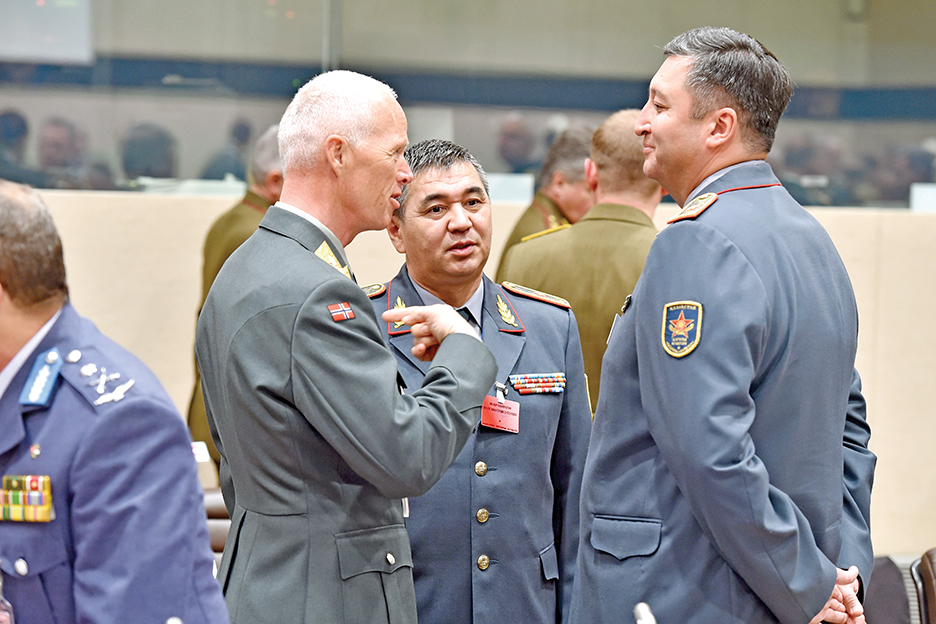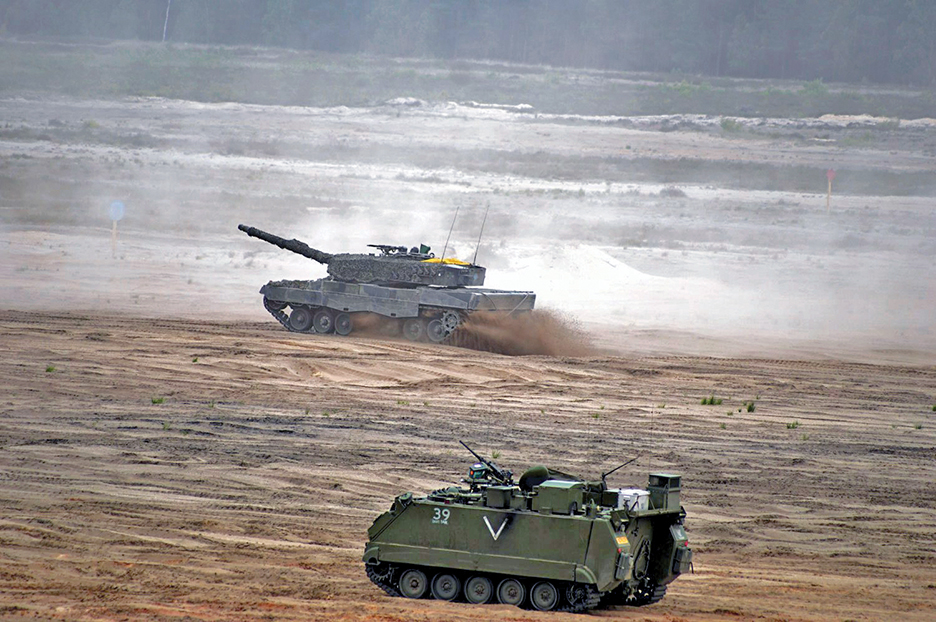A new program builds intellectual interoperability among NATO members
By Dr. Judith Reid, EUCOM
The Defense Institution Building Program at U.S. European Command works with partner nations to help them move toward intellectual interoperability with NATO. As the International Security Assistance Force mission in Afghanistan wanes and most armed forces are shrinking toward peacetime forces and budgets, NATO and partner nations need to maintain meaningful peacetime connections and continue training and exercising with each other to prepare for the next conflict. Part of that preparation is to improve interoperability at the strategic level to create intellectual interoperability.
Many of our partners regularly undertake defense reviews. As their defense leaders work through political direction and mandates, operational realities and funding cuts, it often seems that little can be achieved. It’s as if every streamlining initiative is connected to another in a cascading matrix toward the same bottom line: no money and smaller, less capable forces.
Allow me to offer another perspective on improving the current state of strategic planning. Instead of seeing nonstop cutbacks and “salami-sliced” operating budgets, take a wider-lens viewpoint to gain a positive outlook on the strategic planning process.

Strategic Planning Process
Ends, ways and means — in business, these terms mean what the organization wants to bring to market, the manufacturing and operational processes that create the product, and the resources needed to succeed. In the military, we refer to these as mission, operations and resources. Both set priorities and mitigate risk to meet the desired end state.
Mission is first. In business, the key to success is understanding where a product or service falls in the supply and demand cycle. Market analysis discerns customer needs and desires and generates an evaluation of the product or service and the source of its demand in the marketplace. The military equivalent could be a threat assessment or defining a desired capability to achieve a specific end state. In both cases, an external analysis is performed to better understand the political, economic, social, technical and environmental macro trends in effect at that time and expected over the ensuing two to five years. Military planners identify potential threats and align or create the capabilities needed to counter them based on similar external trend analyses.
Next, we make it happen. Once a product or service is conceptualized, how does it materialize? What does it do? How does it work? What is the process? If it is a product, then what raw materials get cast, smashed, drilled and pounded into place to create the finished product? How many are produced in an hour, a day or a year? If it is a service, what raw materials of time, human capacity, physical space and intellectual property come together to create a deliverable expertise? In the military, which weapon platforms combine with software and human skill to produce a capability desired to help ensure national security?
Finally, we pay for it. Resources — a reliable funding stream — are required to bring the product, service or military capability into existence. Employees must be recruited, trained, retained, retired and removed as needed based upon the needs of the operation. And soldiers must be trained with the knowledge, skills and abilities needed to operate the platforms. Logistical pipelines for fuel, replacement parts, lubricants and raw materials must hum in a chorus of productivity.
These three key elements of business or military activity compete against each other for time, attention, money and space. This is a constant problem. If the market demands gold-plated cars, it is not just a question of paying for the gold with the resources available, but also of whether gold is a viable metal for manufacturing cars. And if an entity develops software to run that car, are there enough qualified software designers available who understand not just the code that needs to be written, but how to design software that fulfills market demand? If the military requirement is to fly refueling missions within a 500-mile radius, the challenge is more than whether there is enough fuel for the plane. It is also whether a suitable plane exists — in good condition, with the required up-to-date technology — and if a runway that can accommodate its weight is available, plus a host of other operational issues that will determine whether the mission can be accomplished.
Finding the Resources
Resource issues might include a runway in need of repair or the availability of operationally ready refueling planes to support additional flight training time. Where does the money come from? If there is no more money, how can more be generated? Will the public accept a tax increase? Can unused military assets be sold on the open market? Can expenses be minimized to free up cash? In short, there is no such thing as a 99 percent capability.
These questions lead to more questions: Can the operation be adjusted to be more cost-efficient? Does that car have to be gold plated? Do we need software designers for every bit of code writing, or can we use lesser-paid code writers to handle the boilerplate sections? Does our refueling plane need its own airport, or can we use a civilian airport? There are constant re-evaluations and tradeoffs to be made in determining the desired results, the operational procedures to achieve those results and the ability to acquire the necessary resources.
This requires compromise and consensus building. Give a little here and take a little there until the capability is acceptable, the operations are workable and the resources are manageable. These are hard but necessary choices. How does a country restructure its budget to reduce the personnel costs of too many older officers? How can the maintenance costs of advanced new platforms be included in a wish list to hardware providers? How does one stop perpetuating support for corrupt leadership and move toward merit-based, fiscally sustainable prudence?

Efficiency in Cooperation
For each country struggling to balance its budget, there are different answers. The solution begins with turning away from old, outdated attitudes and methodologies and moving toward an affordable future within the NATO community. Rather than a country seeing itself as dependent on a greater whole, each country should see itself as a responsible, contributing member of an alliance. That requires an in-depth analysis to balance ends, ways and means. As such, when a country commits a capability to NATO, that commitment is undergirded by an affordable, operational plan.
The process is not linear, and can start anywhere, particularly where quick successes can be achieved to jump-start the process of change. For example, perhaps a country wants to improve its medical trauma care. In many countries, civilian hospitals treat injuries like mild traumatic brain injuries or provide long-term amputee care. While this specialized medical knowledge is core to military medical care, it can also benefit the local population in emergency trauma care. For a small investment in the armed forces, the country could buy this specialized capability for the general population.
Or perhaps a country wants to become NATO interoperable. After the fall of the Berlin Wall, NATO created and has maintained accession processes to guide aspiring countries to membership. There are membership action plans, individual partnership action plans, annual national programs, and Partnership for Peace planning and review processes. NATO standardization agreements detail the operational capabilities necessary to join or operate effectively with Alliance forces — for example, English language capability or the ability of troops to understand and utilize a particular piece of hardware. This operational objective focuses efforts to meet the goal of NATO interoperability, but could cost more than some aspirants’ coffers will allow.
Another country may want to pay for new programs. If generating more revenue is not feasible, what cost-cutting measures can be implemented within the defense department to harness efficiencies? Can excess equipment be repurposed? Can military real property assets be reallocated to other government agencies or liquidated to private entities? Can retirement benefits be reworked to cost less? Where are the pockets of opaque financial transactions that can be made transparent? More cash means more capacity to recruit new troops or prepare to join NATO. This would lead to a more ready and able military force that supports a country’s security needs.
Conclusion
The ends-ways-means triangle represents a natural tension among desired mission readiness, operational requirements and resource availability. In this case, tension is good. This tension forces each major decision to be weighed against other possible courses of action. Additionally, planners are compelled to prove an action’s value. Military models see the ends as immovable, though business models do not. If operations cannot produce a particular desired effect with the resources available, then the “ends” must be re-evaluated and potentially adjusted to achieve the goal within the parameters of available operational and resource capabilities. The mission accepts risks if the “ends” are to reach NATO interoperability, but the ways and means are not yet available to achieve that goal. In that case, focus shifts to defining the stepping stones toward the NATO interoperability goal that could be attained in the near term. The constant adjustment among the three requires a continual rebalancing of each.
In the business community, the outside variable is profit. Will the dance among the three — product, operations and resources — create something that the market wants and will buy? The outside variable for the military is whether the combined efforts of ends-ways-means can produce security sector services that are of value to the nation and are attainable.
The process is not linear, or even hierarchical; it is circular and possibly even three dimensional. It should not be seen as shaving away each of the points on the triangle until parity is reached, but rather as interactively creating a holistic picture that is balanced, realistic and achievable. The tension inside the triangle is necessary for checks and balance to the strategic planning process, and can help create elegant solutions to security challenges. The process of thinking through and making choices is something in which most Western ministries of defense routinely engage, which means that this decision process undergirds intellectual interoperability in the Alliance.
As governments contribute fewer resources to military spending, balancing ends, ways and means is key to every military’s strategic success. It is also at the heart of NATO intellectual interoperability. ο


Comments are closed.